Table of Contents[Hide][Show]
What are healthy carbohydrates for people with type 2 diabetes and prediabetes?
What are you supposed to be eating? Especially to keep your blood sugar levels in a healthy range?
These are common questions that can be confusing so let’s get straight to business and dig in and answer those questions now.
RANDOM FACT
The body has essential needs for amino acids (protein) and fats but there are no essential carbohydrates required!
That’s a crazy fact, right!
Of course that doesn’t mean we live without carbohydrates, because we love carbohydrates of all kinds, a little too much most of the time. 😉
Carbohydrates as a food group are one of the healthiest for us – they provide vitamins, minerals, phytochemicals, and compounds that are beneficial for our health, and they also provide fibre, too.
But… not all carbohydrates are created equal. And when it comes to maintaining healthy blood sugar levels, the type of carbs you choose is critical.
Thankfully though, there are healthy carbohydrates you can eat and keep blood sugar in a healthy range.
Too Many Carbs Is The Issue
The average person consumes way too many carbohydrate foods – around 800 calories worth per day, according to one study comparing 158 countries!
The thing to understand, is that as a person with diabetes or prediabetes, carbohydrates are the type of food you need to get a good handle on. Why?
Because the amount of carbs you eat influences your blood sugar and HbA1c more than any other nutrient!!
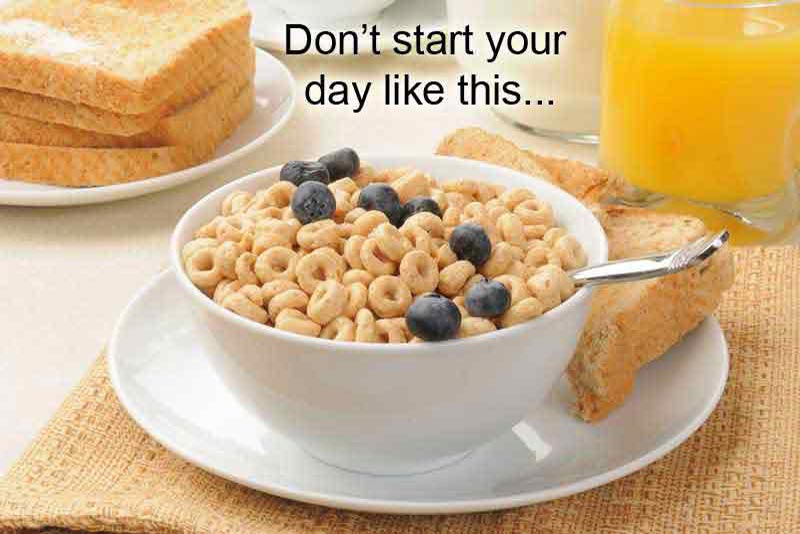
Let’s take a look at a typical day on a Western diet plan:
Breakfast: Toast with a glass of orange juice – carbs.
Morning tea: 1 small blueberry muffin – carbs.
Lunch: A ham salad sandwich and a coke – carbs.
Afternoon tea: A packet of salt and vinegar chips and a choc chip cookie – carbs.
Dinner: Spaghetti pasta with a jar of sugar-filled bolognese sauce – carbs.
Dessert: 1/2 cup chocolate ice cream – carbs!!
Nutrition Breakdown Of The Average Menu

As you can see, carbohydrates total to around 337 g for just one day eating such a menu. Even just one day like this can be problematic, let alone eating that many carbs day in and day out.
It also provides very little in the way of nutritional quality. Studies indicate that while the average person tends to eat a lot these days we have rising levels of nutritional deficiencies, even in Western societies where food is ample!
In terms of carbohydrates and diabetes, it’s been an interesting history. For many, many years, people with diabetes or prediabetes have been told to eat more carbohydrates and less protein and fat – that’s been a very common recommendation for decades. Unfortunately, this is very problematic because as a person with diabetes your body has lost the capacity to deal with glucose (carbs/sugar) in the blood effectively.
While every person does have a different level of carb intolerance, a lower carb diet has proven one of the most effective methods for lowering blood sugar and HbA1c levels.
How Carbs Affect Your Body
Let’s just get back to basics for a second and focus on how carbs influence your body.
The written explanation
You eat carbohydrates -> Your body processes this and as a natural response your blood glucose rises -> Your pancreas releases the hormone insulin to lower your blood glucose -> As a person with diabetes, you have an inability to uptake glucose into the cell effectively, which leaves your blood glucose high (this is called insulin resistance) -> More insulin in the bloodstream increases insulin resistance -> Insulin is also the fat storage hormone so all the excess glucose in your blood gets pushed into fat cells -> This increases triglycerides and cholesterol levels and increases inflammation causing more issues. -> So it can become a bit of a repetitive cycle.
The video explanation
Here’s a simple video that shows how the carbohydrates we eat triggers insulin.
The affect of carbohydrate intake on blood glucose occurs whether we have diabetes, prediabetes or not. Carbohydrates are carbohydrates. This is the natural physiological response of the body. But, as a person with diabetes or prediabetes, your ability to deal with the carbs has become impaired.
So how can you lower and control this high blood glucose?
You have to change gears on the type of carbohydrates you eat.
Carbohydrate Basics
When you think of carbohydrates, it probably brings to mind things like potatoes, rice, pasta and bread. And more than likely, many things on this common list of carb sources include processed and refined foods such as white bread, white pasta, and white rice, which are high energy carbohydrate foods that will spike your blood sugar much quicker than a complex carb.
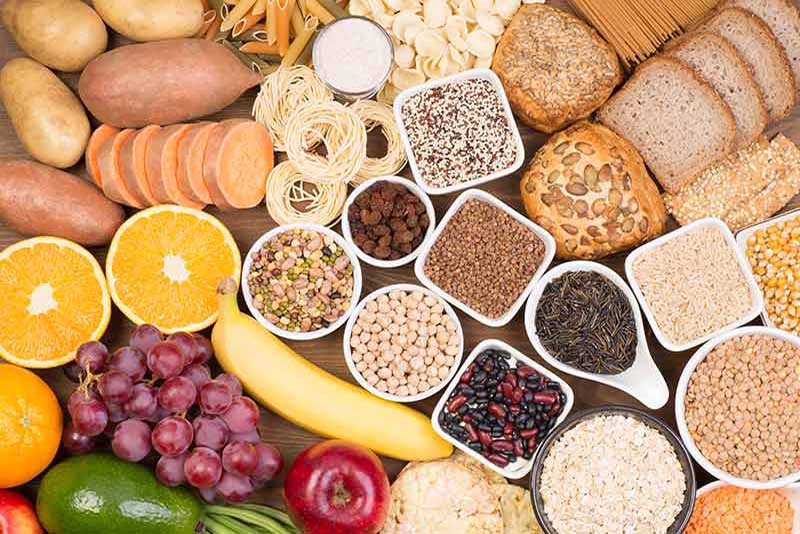
Simple and Complex Carbs
Simple sugars/carbs – refined white sugars, white flours, white breads, white pastas – these uptake into the bloodstream with little digestive processing needed, and therefore, they tend to spike blood sugar faster and higher.
Complex sugars/carbs – have to get processed and converted to glucose and take longer to enter the bloodstream. Complex carbohydrates are often higher in dietary fibre, and the fibre is there to slow digestion and absorption of glucose so that blood sugar raises slower and hormone levels stay more stable.
Here’s a list of some of simple and complex carbs so you can see the difference between them:
Avoid ALL Simple Carbs
- white sugar
- white flour
- white bread
- white pasta
- soft drinks & sodas
- energy drinks
- fruit juices
- many cereals
- many crackers
- many sauces and condiments
- processed food
- ice creams
- cakes & cookies
- pies
- fruit
- honey
Better Choices BUT there’s more to it (see below)
- whole grains
- whole grain breads
- whole grain crackers like brown rice cakes
- gluten free wholegrain pastas
- brown rice
- quinoa
- buckwheat
- vegetables – loads of them to choose from
- beans and legumes such as:
- chickpeas
- lentils
- adzuki beans
- borlotti beans
- navy beans
- wild rice
- oats
- sweet potato
It’s good to be aware of what simple and complex carbs are because if you go read other websites you will notice that the carbohydrate advice for people with diabetes, often says to include complex carbs. It certainly is true that complex carbs are a better choice than simple carbs.
However, what you need to know is that…
All types of carbohydrates break down to glucose/sugar in the blood, period!
Even if it takes longer to digest, the glucose is still going to end up in your bloodstream!
That means even complex carbs from things like grains can be problematic because they are high in carbohydrate content. So let’s dig even deeper to find out why and what your best choices are.
Complex Carb Choices
Basically you have 4 categories of complex carbs to choose from:
- Vegetables
- Fruit
- Whole grains
- Beans and legumes
Let’s cover each one of these categories in more detail.
Eat More Veggies
Vegetables are a complex carbohydrate!
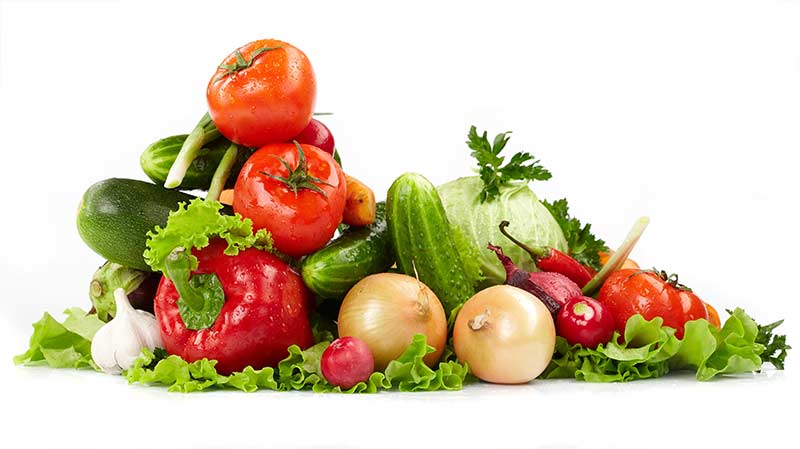
Most people don’t think of vegetables when they think of carbs.
However, vegetables are the type of carbs you really need to focus on eating more of, because they are more nutrient dense – meaning, they are full of vital vitamins, minerals, antioxidants, and other compounds that the body needs to fuel it’s optimal function.
Statistics show that only 8% of the population are eating the recommended 5 servings a day of vegetables, with 25% getting only one serve a day, and the rest…well they are not eating any veggies at all!
One serving of vegetables is equivalent to around half a cup so 2.5 cups a day minimum is the main aim. With diabetes though, since you need to cut down on other complex high carb foods – potatoes, rice, bread, pasta – you can be eating way more than 2.5 cups of veggies per day.
Vegetables contain so many valuable nutrients and compounds that can guard us against disease. They reduce energy density of the diet, helping you lose weight. They provide valuable fibre that helps promote healthy digestion, they help reduce sugar cravings, and they just make you feel great.
Vegetables are by far the very best form of carbohydrate for you to choose, well at least most of them are.
Types of Vegetables to Include & Avoid
AVOID
- Potatoes
- Sweet potato
- Yams
- Plantains
- Corn
MODERATE
- Carrots
- Beetroot
- Parsnip
- Pumpkin
- Swede
INCLUDE
- Green leafy veggies
- Broccoli
- Cauliflower
- Cucumber
- Tomatoes
- Bell pepper
- Leeks
- Eggplant
- Zucchini
- Squash
- Snow peas
- And many others
Fruit
Fruit is a natural food source so if you were to choose something sweet you’d be far better to choose a small piece of fruit.
However, most fruit also happens to be a high source of carbohydrates. Despite commonly held assumptions that fruit juice is healthy, it’s not.
Fruit juice is a BIG NO NO!
It’s extremely high in sugar/ carbs.
Take a look at this apple verse apple juice comparison.
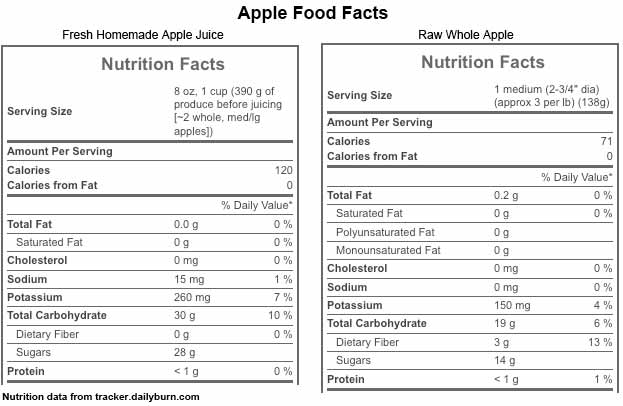
As you can see, eating the whole apple provides 19 g total carbs, 3 g fibre, 14 g sugar. Whereas, if you drink 1 cup apple juice, it sharply increases the carb and sugar count, and decreases fibre.
All and all, when it comes to fruit, the best fruits for people with diabetes are berries such as strawberries, raspberries, blueberries. These are lower carb options that won’t have a great impact on blood sugar and A1c. You can have around 1/2 cup per serve. Berries make a nice dessert served with something like cottage cheese or yogurt.
Whole Grains
Now we’ve already covered all the white processed forms of grains above. Things like white rice, white pasta, white bread, white flour, and packaged foods that often contain simple carbs, and sorry to say but these all have to get the cut.
What about whole grains?
Well, they are a complex carbohydrate and you can eat whole grains and count carbs and monitor your intake. BUT it is far, far easier to get better results if you AVOID ALL GRAINS!
Did you just say avoid all grains?
Yes; or at least minimise them to very little intake.
The American Diabetes Association 2017 Standards of Medical Care in Diabetes, state that: “whole-grain consumption is not associated with improvements in glycemic control in type 2 diabetes.”
Or in other words, whole grains do not help you regulate blood sugar and HbA1c – that’s what the research clearly shows again and again. There is no evidence to suggest whole grains benefit blood sugar in any way, quite simply because they are a high carb food. Hopefully by now you are beginning to understand their strong influence on your numbers.
Eliminating grains, or at the very least cutting them down drastically, is initially a challenge for many people but if you REALLY want to control your blood sugar, easier, then avoiding grains is the way to go. It also helps to un-complicate things for you, allowing you to enjoy your food more without having to worry so much about counting every single carb.
Sure, it’s an adjustment. But you certainly won’t starve.
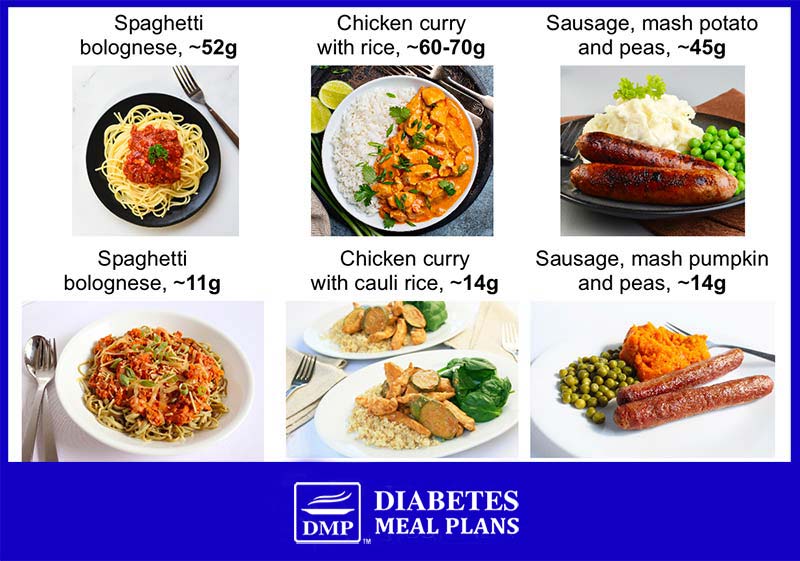
There are plenty of things you can still eat – if you’re stuck for ideas, check out our weekly meal plans.
Anyway, let’s just get back to the whole grain debate for just one minute.
Example
Let’s just say you want to have a couple of slices of toast for breakfast or some brown rice with dinner and you’re aiming to keep your carb count to 30 g per meal.
- Brown rice has a carb count of approximately 19 g per serve (1/2 cup). Now half a cup isn’t that much, and most people normally eat more than this (it’s easy to do). You would have to measure your portion sizes AND keep a closer check on your blood sugar levels.
- 1 slice whole grain toast has an average carb count of 12-15 g per serve. If you wanted to eat 2 slices that bumps you up to 25-30 g just for just the toast, without any toppings.
What most people don’t realise is that grain based foods are very high in carbohydrates. So avoiding them, at least for the most part, cuts out a majorly big hassle for you, and helps you control blood sugar and HbA1C levels much easier.
Beans & Legumes
Beans and legumes include things like adzuki beans, chickpeas, brown and red lentils, lima beans, borlotti beans, broad beans, fava beans, garbanzo, lima beans, navy beans, mung beans, and so forth.
These do contain protein, but what many people do not realise is they are predominantly a carbohydrate food.
While beans and legumes are beneficial for feeding gut bacteria that support our health, you need to keep a tight limit on your portions.
Here is the approximate carbs for some beans and legumes (per 1/4 cup):
- Edamame (young soy beans) – 1.7 g
- Soy beans – 4.2 g
- Northern beans – 6 g
- Lentils – 6 g
- Black beans – 6.5 g
- Navy beans – 7 g
- Pinto beans – 7.5 g
- Red kidney beans – 7.5 g
- Chickpeas (Garbanzo) – 10 g
There is research to show that the soluble fibre and resistant starch in beans and legumes provide some great health benefits o for most people with type 2 diabetes, it’s okay to eat small portions of beans and legumes in moderation (recommendation, 1/4 cup per serve).
In particular, resistant starch is beneficial for promoting good gut bacteria, and producing short chain fatty acids that play important roles in lipid, glucose, and cholesterol metabolism.
TIP: To get the most resistant starch out of beans and legumes, it’s best to cook them and cool them, then reheat them if you wish to use them in a meal. The heating and cooling, increases the amount of resistant starch in them.
Note though, some people with diabetes will not be able to tolerate any beans or legumes. The only real way to know is to use your blood sugar monitor and assess how foods influence you.
What can I eat then?
Right now you may feel like you won’t be able to eat anything. We assure you this is certainly not true!
It can take some adjustment, but there is still plenty you can eat. That’s exactly why we created an amazing low carb meal planning service, to help make diabetes eating a lot easier!
In any case, you probably have a few questions, like:
- What will I eat for breakfast?
- What about bread? Can I still eat bread?
- Or what’s the healthy amount of carbohydrates to eat?
Let’s give a few brief answers now…
What will I eat for breakfast?
Breakfast cereals are off the list, at least the kind you find on the supermarket shelf. Yes, even things like weetbix and whole grain options, and even oatmeal in many cases, we’ve already talked about why – they are high in carbs.
When it comes to bread, there’s no doubt that it’s something that everyone loves, but we can definitely live without it, plenty of people do. Of course, there are some low carb bread options available now too:
- Aldi has the Bakers Life 85% Low Carb Bread
- Woolworths has the Macro Linseed & Sunflower Low Carb Loaf
- Woolworths low carb wrap bread
- Coles Alpine low carb bread
- Coles has Mission Low Carb Wrap Bread
- Simsons Pantry low carb wrap bread
- Helgas lower carb wrap bread
What are your breakfast options?
We’ve been conditioned to think we need to eat cereal for breakfast because we have this idea in our head about what breakfast foods are, we’ve just been raised like that.
But what you need to be eating for breakfast is a real wholesome meal loaded with good food. The beginning of the day is the most critical time to eat a good meal in order to sustain your energy, balance your hormones, and prevent sugar cravings and binge attacks later in the day.
The trick is to start thinking about breakfast differently.
Why not have egg muffins, make a low carb muesli with nuts, eat a chicken and vegetable soup for breakfast (yes, soup works well for breakfast!), or have some eggs and veggies – like a mixed veggie omelet.


KEY POINTS
Just to clarify what you’re aiming for in choosing healthy carbohydrate sources to manage your type 2 diabetes or prediabetes.
1. Eat more vegetables
Especially vegetables that grow above the ground such as green leafy veggies, broccoli, cauliflower, cucumber, tomato and so forth.
Vegetables are your number one main priority and inclusion – mainly non-starchy vegetables. There is such a wide variety to choose from that you will never get bored. The aim is a minimum of 5 serves a day – equal to about 2.5 cups, but you should easily be able to eat more.
2. Eat moderate carb vegetables in moderation
This includes veggies like pumpkin, beets, celeriac and turnip.
3. Eat lower carb fruits
Berries such as strawberries, blackberries, blueberries, raspberries are the best options. Followed by passionfruit (1), cantaloupe/rockmelon (1/2 cup), guava (1), plum (1).
4. Limit beans and legumes
Beans and legumes are higher in carbs than protein so monitor your portions. Edamame (young soy beans) is the lowest carb option, followed by soybeans, lentils, black beans and northern beans.
5. Exclude, or greatly limit, grain-based foods
Pasta, rice, noodles, crackers, cakes, bread, pastries and so forth. This includes whole grain options too.
6. Exclude, or greatly limit, starchy high carb vegetables
Potatoes, sweet potatoes, yams, plantain and corn.
As a rule do not displace vegetables for any other type of food, you must get those veggies for their super nutritional power!
If you stick to the above ‘rules’ for selecting healthy carbohydrates, you will find yourself having less struggles with lowering and maintaining blood sugar!
Please share this great resource around with other friends, family and colleagues who may need it.
P.S. You may also like to read:

